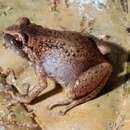Oreophryne anamiatoi: Brief Summary
provided by wikipedia EN
Oreophryne anamiatoi is a species of frog in the family Microhylidae endemic to Papua New Guinea.
- license
- cc-by-sa-3.0
- copyright
- Wikipedia authors and editors
Description
provided by Zookeys
Description of holotype. Adult female with incision on right side. Head wide (HW/SV = 0.40), with steep, slightly concave loreal region. Canthus rostralis rounded, concave when viewed from above. Nostrils directed laterally, closer to tip of snout than to eyes. Internarial distance broader than distance from naris to eye (EN/IN = 0.80, IN/SV = 0.101, EN/SV = 0.081). Snout truncate when viewed from the side, shallowly angulate when viewed from above. Eyes moderately large (EY/SV = 0.11); eyelid approximately two-thirds width of interorbital distance. Tympanum distinct but small (TY/SV = 0.047). Dorsal skin granular with series of weakly raised parallel ridges and scattered small pustules; ventral surfaces coarsely granular. Supratympanic fold narrow. Fingers unwebbed, bearing discs with terminal grooves; relative lengths 3>4>2>1. Finger discs approximately 3 times widths of penultimate phalanges, except for first finger, which is approximately twice width of penultimate phalanx. Subarticular tubercles well developed; inner metacarpal tubercle oval and low; outer rounded and obscure. Toes unwebbed, bearing discs with terminal grooves; relative lengths 4>5>3>2>1. Toe discs smaller than those of fingers (3rdF/4thT = 1.37), approximately twice width of penultimate phalanges. Subarticular tubercles low but distinct; inner metatarsal tubercle large, oval; outer absent. Hind legs of moderate length (TL/SV = 0.46).
In preservative, dorsum medium brown with small black flecks scattered throughout, these concentrated dorsolaterally, mid-dorsally, and on top of head. Entire face to posterior of jaw angle uniform dark brown. Dark-brown postocular stripe extends along ventral side of supratympanic ridge. Rear and front of thighs uniform medium brown. Tops of wrist, hand, and first three fingers boldly marked with dark brown. Sides darker brown with very pale straw flecks. Venter very pale straw with bold, large, dark-brown flecks, these dense on chin, throat, and under legs, sparse on abdomen. Palmar and plantar surfaces dark brown spotted with very pale straw. Iris dark brown minutely flecked with silver.
Variation. Mensural variation for the type series is shown in Table 5. Sexual dimorphism is slight except that females clearly attain larger size than males and may have slightly narrower snouts (reflected in EN/IN values).
Dorsal ground color varies from light brown to dark brown, and pattern varies from virtually absent to moderately well stippled and streaked with black. Black stippling may be uniformly distributed, or concentrated laterally or dorsolaterally. Two specimens have a narrow tan vertebral stripe margined with black stippling. The dark face and postocular bar are present in all. Venters of all specimens are boldly spotted with dark brown on white, but two specimens have the abdomen clear and a few others have it less spotted than the chin and throat.
Color in life. BPBM 33764 (Fig. 1C): “Dorsum medium brown with a slight russet cast. Face dark brown; short dark-brown postocular dash; and few dark-brown lateral flecks. Rear of thighs brown, slightly darker than dorsum. Venter pale yellow heavily flecked with dark gray. Iris bronze with narrow red rim around pupil. Upper arms and tarsi burnt orange.” BPBM 33765 was uniform brown dorsally with a dark face mask and postocular stripe (Fig. 1D); rear and front of thighs, and groin, uniform brown, slightly darker than dorsum; venter dirty cream flecked with gray; iris dark brown. BPBM 33766 had black flecks on sides and venter brighter yellow but with fewer gray flecks and with white chromatophores; BPBM 33767 had the dorsum and rear of thighs burnt orange and venter pale yellow; BPBM 33769 and 33771 had a tan vertebral line. BPBM 33774 had a metallic green sheen on eyelids and top of snout; BPBM 33776 same but less extensive. PNGNM 24097 was light brown with straw yellow on sides, with dark-brown spots dorsally and laterally, denser on sides; face to rictus and short postocular stripe dark brown; rear of thighs brown like dorsum but unspotted; venter pale yellow spotted with dark-gray flecks; iris brown.
Call. Animals called during the first few hours of darkness. We recorded ten calls from two individuals (Table 6). The calls from both were similar, so we combined data from both for analysis.
The call consists of 17–22 pulsed notes (Figs. 8A, 9A). Note duration was similar over the course of the call and averaged 0.0569 s (range 0.0266–0.0681). Internote intervals were also similar throughout the call and were similar in duration to the notes, averaging 0.0563 s (range 0.0390–0.0942). Mean call duration was 2.10s (range 1.77–2.33), and notes were delivered at a mean repetition rate of 18.5 notes/s (range 17.3–20.3). Number of pulses/note ranged from 3–11 (Fig. 9A), with a strong tendency to decrease over the course of the call (Fig 10). Modal number of pulses in the first three notes in each call ranged from 10–11, producing a mean rate for those notes of 200.9 pulses/s, while modal number of pulses in the last three notes ranged from 7–9, producing a mean rate for those notes of 146.4 pulses/s (Table 7). Notes are finely tuned, with a mean dominant frequency of 2490 Hz (range 2460–2540) (Fig. 8B–C, 9B–C) and no frequency modulation over the duration of the note.
- bibliographic citation
- New microhylid frogs from the Muller Range, Papua New Guinea.
Distribution
provided by Zookeys
Known only from the vicinity of the type locality on the northeastern slopes of the Muller Range, Southern Highlands Province, Papua New Guinea (Fig. 4).

